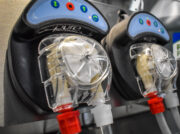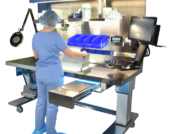
A High-Level Approach to Staffing & Retention Problems
Staffing & retention is a problem most sterile processing leaders are familiar with, and there’s no silver bullet to resolving it. In fact, approaching staffing & retention concerns from a single angle isn’t likely to deliver a lasting remedy. So how can SPD leaders deliver lasting, meaningful changes to address staffing concerns? Listen to what sterile processing is saying about those challenges.
The 2023 SPD State of the Industry Report delivered many insights into what sterile processing professionals are saying, thinking, and experiencing, as well as what concerns they have about the industry. While you won’t find a staffing & retention silver bullet, insights from throughout the report provide valuable windows into where to look to keep great people for your department.
Where to look
Determining how people are finding their way into sterile processing jobs is a good first step to hyper-focusing your hiring efforts.
- 43.27% found an open position without prior knowledge of SPD.
- 28.65% were referred by a friend or colleague.
- 14.62% moved from another department in the hospital/facility.
- 13.45% pursued education at a university/college with the intent of starting a career in SPD.
So, what should be done with this information to help you find new teammates?
- Get your open positions in front of people outside of the healthcare industry. Nearly half of the survey participants didn’t know anything about SPD before applying.
- Spread the word! With more than a quarter of participants coming to SPD via referral, you and your team’s network might be the key to filling open roles with great people.
- Leverage your relationships in the hospital. Almost 15% of participants came from a different department in the same hospital they were already employed. Your next teammate may already be in the building.
- Conduct outreach to local high schools to raise awareness about careers in SPD. Couple this with visits to universities and colleges in the area with related programs and certifications to create a well-rounded approach to tapping the labor market in your area.
Tip: Many participants entered sterile processing from their time in the armed services. From military-dental careers, scrub techs, surgical technologists, and more in the both the US Army and Navy, veterans are finding their way to SPD. Use this information to narrow and tailor your search for new teammates. Websites specifically focused on recruiting members from the armed services are also available.
How to keep great teammates
Once you’ve brought great people into your team, it’s even more important to make sure they want to stick around. Here are some of the problems participants considered to be the most important to solve, and the positive impacts to retention:
*Pay and benefits has been omitted; it doesn’t take a report to know that competitive pay & benefits improve retention.
- Update equipment: Antiquated equipment isn’t just inefficient; it can cause ergonomic challenges, create bottlenecks, and generally make sterile processing’s job more difficult, expediting burnout. Modern, updated equipment can make all the difference.
- Focus on culture: Culture was a top concern that showed up many times throughout the survey. Having a great culture not only helps technicians grow but demonstrates appreciation, holds teammates accountable, and creates a healthy workplace. Request a free pad of Citations for Being Awesome to show your team appreciation!
- Provide training & education: Give teammates the opportunity to grow and improve themselves through training and educational opportunities. This can range from training courses, to paid time to study for certifications, to getting them to local and national industry events, such as the HSPA Conference. Local conferences are another great, cheaper alternative to education and networking.
Recognize their value
Participants freely shared what they enjoy most about working in sterile processing. Putting an emphasis on and reinforcing these ideas can help your team feel fulfilled in their work:
- Patient Safety/Care: Participants viewed their role in keeping patients safe as the most rewarding aspect of working in sterile processing. Despite not interacting with patients face-to-face, SPD technicians play a critical role in their safety and recovery during and after surgery.
- Variety of work: There’s no shortage of things to do in a sterile processing department. Rotating teammates throughout the department not only helps develop a well-rounded team but keeps the work interesting on day-to-day basis.
- Team: A strong sense of team and camaraderie was a rewarding part of many participants’ job. Taking time for team building and helping the team meld can fuel synergy and foster a supportive atmosphere that fuels accountability.
- Learning: Participants indicated that a source of fulfillment in SPD is the opportunity to expand their knowledge of the job and continue learning. Affording opportunities to continue education and interact with various areas of the department will bolster enthusiasm.
Conclusion
There’s a lot to consider when taking on a staffing & retention challenge. From marketing opportunities, identifying candidates, improving the department, and keeping the team fulfilled, it’s not something that can be easily done overnight. Slowly implementing these factors over the months and years your department continues to grow can help them take root organically and create a department people want to be a part of.
Interested in digging into the full 2023 SPD State of the Industry Report? Download it for free!
Looking to get more information on some of the topics in this post? Check these out to get the ball rolling:
Sterile Processing Training and Education Best Practices
Identifying Educational Needs for Your Department
Solutions for the Top Ergonomic Issues in Reprocessing Departments
Appreciation – The Key to Retention
Establishing & Maintaining a Great Culture in Sterile Processing
Does Ergonomics Drive Employee Satisfaction in Instrument Processing?
The SPD State of the Industry Survey is an annual, free, anonymous survey asking real sterile processing professionals across the country about their experiences, backgrounds, and challenges they face in their departments. We hope by providing access to free industry research and data, instrument reprocessing professionals can better grow, develop and improve their own departments through the experience of their peers. We are grateful for all the professionals who participate each year, and the contributions to their patients and facilities: thank you for all you do!




